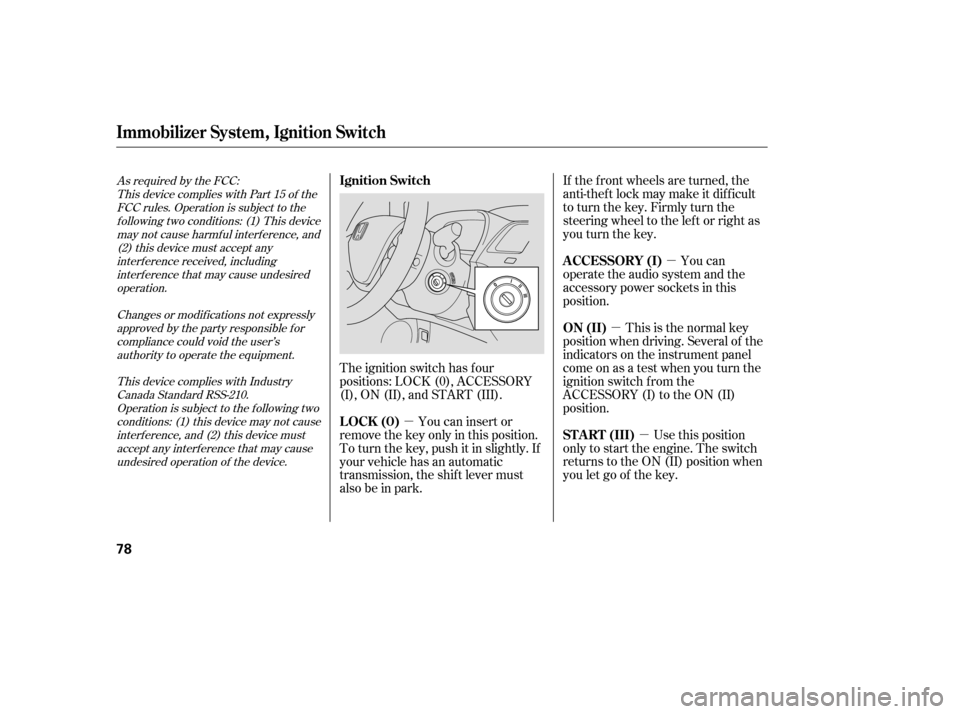Page 68 of 304
This indicator comes on when the
security system is set. See pagef or more inf ormation on the
security system. The engine can be severely damaged
if this indicator f lashes or stays on
when the engine is running. For
more inf ormation, see page .
If this indicator comes on when the
engine is running, the battery is not
being charged. For more inf ormation,
see page .
See page .
268
267
267
170
If equipped
Security System Indicator Malf unction Indicator Lamp
L ow Oil Pressure
Indicator
Charging System
Indicator
Instrument Panel Indicators
Inst rument s and Cont rols
65
SECURITY SYSTEM INDICATOR
�����—�����—�����y���������������y���
�(�#�����
���y���������y
Page 69 of 304
To switch the information display
between the odometer, trip meter,
outside temperature (if equipped),
and engine oil lif e and maintenance
item code(s), press the SEL/RESET
button repeatedly.
Press and hold until the speedometer,
trip meter, and odometer readings
switch between miles per hour and
kilometers per hour. A beeper willsound.
This shows the total distance your
vehicle has been driven. It measures
miles or kilometers.
It is illegal under U.S. f ederal law and
Canadian provincial regulations to
disconnect, reset, or alter the
odometer with the intent to change
the number of miles or kilometers
indicated.
Odometer
Display Change Button
Gauges
66
TEMPERATURE GAUGE
TRIP METER
SPEEDOMETER
FUEL
GAUGE
SEL/RESET BUTTON DISPLAY CHANGE BUTTON INFORMATION
DISPLAY
TACHOMETER
ODOMETER/OUTSIDE
TEMPERATURE INDICATOR INSTRUMENT PANEL BRIGHTNESS CONTROL BUTTONS
U.S. model with A/T is shown
�����—�����—�����y�����������
���y���
�(�#�����
���y�������
�y
Page 70 of 304

Each trip meter works independently,
so you can keep track of two
dif f erent distances.
There are two trip meters: TRIP A
and TRIP B. Switch between these
displays by pressing the SEL/
RESET button repeatedly. This shows how much f uel you have.
It may show slightly more or less
than the actual amount.
To reset a trip meter, display it, and
then press and hold the SEL/RESET
button until the number resets to‘‘0.0.’’
This meter shows the number of
miles or kilometers driven since you
last reset it.
This shows the temperature of the
engine’s coolant. During normal
operation, the reading should rise to
about the middle of the gauge. In
severe driving conditions, such as
very hot weather or a long period of
uphill driving, the reading may rise
into the upper half of the gauge. If it
reaches the red (Hot) mark, pull
safely to the side of the road. See
page f or instructions and
precautions on checking the engine
cooling system.
265
Trip Meter Fuel Gauge Temperature Gauge
Gauges
Inst rument s and Cont rols
67
Avoid driving with an extremely low
f uel level. Running out of f uel could
cause the engine to misf ire, damaging
the catalytic converter.
�����—�����—�����y���������������y���
�(�#�����
���y���������y
Page 71 of 304

�¶�¶�µ�µ�µ�µ
�µ�µ �µ
�µ
If equipped
The temperature sensor is in the
f ront bumper. Theref ore, the
temperature reading can be af f ected
by heat ref lection f rom the road
surf ace, engine heat, and the
exhaust f rom surrounding traf f ic.
This can cause an incorrect
temperature reading when your
speed is under 19 mph (30 km/h).
The sensor delays the display update
until it reaches the correct outside
temperature. This may take several
minutes. If the outside temperature is
incorrectly displayed, you can adjust
it up to 5°F ( 3°C) warmer or
cooler.
NOTE: The temperature must be
stabilized bef ore doing this
procedure.
This indicator displays the outside
temperature in Fahrenheit (U.S.
models) or Centigrade (Canadian
models). To see the outside
temperature, press and release the
SEL/RESET button until the
temperature is shown on the
inf ormation display. Select the outside temperature
display, then press the SEL/RESET
button f or 10 seconds. The f ollowing
sequence will appear f or 1 second
each:0,1,2,3,4,5, 5, 4, 3, 2,1,0(U.S.)or0,1,2,3, 3, 2,
1, 0 (Canada).
When it reaches the desired value,
release the SEL/RESET button. You
should see the new outside
temperature displayed.
In certain weather conditions,
temperature readings near f reezing
(32°F, 0°C) could mean that ice is
f orming on the road surf ace. Your vehicle’s on board diagnostic
system will detect a loose or missing
f uel f ill cap as an evaporative system
leak. The f irst time a leak is detected
a ‘‘CHECK FUEL CAP’’ message
appears on the information display.
Turn the engine of f , and conf irm the
f uel f ill cap is installed. If it is, loosen
it, then retighten it until it clicks at
least once. The message should go
off after several days of normal
driving once you tighten or replace
the f uel f ill cap. To scroll to another
display, press the SEL/RESET
button. The ‘‘CHECK FUEL CAP’’
message will appear each time you
restart the engine until the system
turns the message of f .
Outside Temperature Indicator
Check Fuel Cap Message
Gauges
68
�����—�����—�����y���������������y���
�(�#�����
���y���������y
Page 72 of 304
The inf ormation display in the
instrument panel shows you the
engine oil lif e and maintenance
service items when the ignition
switch is in the ON (II) position. This
inf ormation helps to keep you aware
of the periodic maintenance your
vehicle needs f or continued trouble-
f ree driving. Ref er to page f or
more inf ormation.
If the system still detects a leak in
your vehicle’s evaporative emissions
system, the malf unction indicator
lamp (MIL) comes on. If the f uel f ill
cap was not already tightened, turn
the engine of f , and check or
retighten the f uel f ill cap until it
clicks at least once. The MIL should
go off after several days of normal
driving once the cap is tightened or
replaced. If the MIL does not go of f ,
have your vehicle inspected by a
dealer. For more inf ormation, see
page .
213
268 Maintenance Minder
Gauges
Inst rument s and Cont rols
69
�����—�����—�����y���������������y���
�(�#�����
���y���������y
Page 80 of 304

CONT INUED
The system may not recognize your
key’s coding if another immobilizer
key or other metal object (i.e. key
f ob) is near the ignition switch when
you insert the key.
If the system repeatedly does not
recognize the coding of your key,
contact your dealer.
Do not attempt to alter this system
or add other devices to it. Electrical
problems could result that may make
your vehicle undrivable.
If you have lost your key and cannot
start your engine, contact your
dealer.
These keys contain electronic
circuits that are activated by the
immobilizer system. They will not
work to start the engine if the
circuits are damaged.
Protect the keys f rom direct
sunlight, high temperature, and
high humidity.
Donotdropthekeysorsetheavy
objects on them.
Keep the keys away f rom liquids.
If they get wet, dry them
immediately with a sof t cloth.
The keys do not contain batteries.
Do not try to take them apart. When you turn the ignition switch to
the ON (II) position, the immobilizer
system indicator should come on
brief ly, then go of f . If the indicator
starts to blink, it means the system
does not recognize the coding of the
key. Turn the ignition switch to the
LOCK (0) position, remove the key,
reinsert it, and turn the ignition
switch to the ON (II) position again.
The immobilizer system protects
your vehicle f rom thef t. If an
improperly-coded key (or other
device) is used, the engine’s f uel
system is disabled.
On DX model
Keys and Locks, Immobilizer System
Immobilizer System
Inst rument s and Cont rols
77
�����—�����—�����y���������������y���
�(�#�����
���y���������y
Page 81 of 304

�µ
�µ
�µ
�µ If the f ront wheels are turned, the
anti-thef t lock may make it dif f icult
to turn the key. Firmly turn the
steering wheel to the lef t or right as
you turn the key.
You can
operate the audio system and the
accessory power sockets in this
position.
This is the normal key
position when driving. Several of the
indicators on the instrument panel
come on as a test when you turn the
ignition switch f rom the
ACCESSORY (I) to the ON (II)
position.
Use this position
only to start the engine. The switch
returns to the ON (II) position when
you let go of the key.
You can insert or
remove the key only in this position.
To turn the key, push it in slightly. If
your vehicle has an automatic
transmission, the shif t lever must
also be in park.
The ignition switch has f our
positions: LOCK (0), ACCESSORY
(I), ON (II), and START (III).
As required by the FCC:
This device complies with Part 15 of theFCC rules. Operation is subject to thef ollowing two conditions: (1) This device
may not cause harmf ul interf erence, and(2) this device must accept any
interf erence received, includinginterf erence that may cause undesired
operation.
Changes or modif ications not expresslyapproved by the party responsible f or
compliance could void the user’s authority to operate the equipment.
This device complies with IndustryCanada Standard RSS-210. Operation is subject to the f ollowing two
conditions: (1) this device may not causeinterf erence, and (2) this device must
accept any interf erence that may cause undesired operation of the device.
Immobilizer Syst em, Ignition Switch
A CCESSORY (I)
ON (II)
ST A RT (III)
Ignition Switch
LOCK (0)
78
�����—�����—�����y�������������
�y���
�(�#�����
���y���������y
Page 100 of 304

If equipped
Turn the ignition switch to the ON
(II) position bef ore operating the
moonroof switch on the ceiling
console.
To open the moonroof f ully, pull
back the moonroof switch f irmly.
The moonroof opens all the way. To
stop the moonroof f rom opening
f ully, brief ly move the switch in
either direction.
To tilt the moonroof , push the center
of the moonroof switch straight up.
To stop the moonroof f rom tilting
f ully open, push the moonroof switch
forward.To open or close the moonroof
partially, pull or push the moonroof
switch lightly to the f irst detent, and
hold it. The moonroof will stop when
you release the switch.
If your vehicle’s battery is
disconnected or goes dead, or the
driver’s window f use is removed, the
AUTO f unction will be disabled. To
reset the AUTO function after
reconnecting the battery or installing
the f use, do this:
Start the engine. Push down and
hold the driver’s window switch
until the window is f ully open.
Pull and hold the driver’s window
switch to close the window
completely, then hold the switch
f or about 2 seconds.
If the power windows do not operate
properly af ter resetting, have your
vehicle checked by your dealer.
1. 2.
CONT INUED
Moonroof
Power Windows, Moonroof
Inst rument s and Cont rols
97
MOONROOF SWITCH
Tilt
Close Open
�����—�����—�����y�
�������������y���
�(�#�����
���y���
�����y